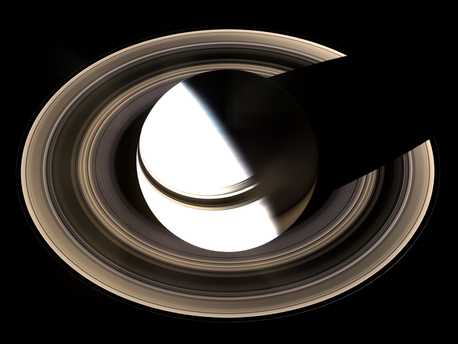Saturn's Ring System
How did Saturn get its rings?
 © NASA/JPL/SSI |
The individual photos making up the picture were taken by the Cassini space probe on January 19, 2007. In order also to capture the dark part of the rings, exposure times were used which mean that Saturn itself is overexposed and therefore shows as white. A section of the ring system lies in Saturn’s shadow.
The origin of Saturn’s rings
The origin of Saturn’s rings is still the subject of debate. Theoretical calculations and measurements from a space probe named after Giovanni Domenica Cassini suggest that the ring system developed out of a cloud of dust and ice, as early as the time of the formation of the Solar System – about 4.6 billion years ago. As the photos from the Cassini probe show, the rings are also continuously fed with material from some of the moons that orbit Saturn in the gaps between the rings. For example, a small moon is distributing its material along its orbit and thereby forming the G ring. The rings of Saturn were named in the order of their discovery and are designated, from the innermost outwards, as the D, C, B, A, F, G and E rings.
The moon Enceladus feeds the E ring. Observations – also by the Cassini space probe – show that geysers on Enceladus are ejecting ice particles with salt in them into space. These particles travel to the E ring and collect there. The presence of the geysers on Enceladus and the detection of salty ice indicate that there is a reservoir of water, or perhaps even an ocean, hidden beneath the moon’s surface.
German Aerospace Center
Saturn's Ring System
How did Saturn get its rings?
 © NASA/JPL/SSI |
The individual photos making up the picture were taken by the Cassini space probe on January 19, 2007. In order also to capture the dark part of the rings, exposure times were used which mean that Saturn itself is overexposed and therefore shows as white. A section of the ring system lies in Saturn’s shadow.
The origin of Saturn’s rings
The origin of Saturn’s rings is still the subject of debate. Theoretical calculations and measurements from a space probe named after Giovanni Domenica Cassini suggest that the ring system developed out of a cloud of dust and ice, as early as the time of the formation of the Solar System – about 4.6 billion years ago. As the photos from the Cassini probe show, the rings are also continuously fed with material from some of the moons that orbit Saturn in the gaps between the rings. For example, a small moon is distributing its material along its orbit and thereby forming the G ring. The rings of Saturn were named in the order of their discovery and are designated, from the innermost outwards, as the D, C, B, A, F, G and E rings.
The moon Enceladus feeds the E ring. Observations – also by the Cassini space probe – show that geysers on Enceladus are ejecting ice particles with salt in them into space. These particles travel to the E ring and collect there. The presence of the geysers on Enceladus and the detection of salty ice indicate that there is a reservoir of water, or perhaps even an ocean, hidden beneath the moon’s surface.
German Aerospace Center





